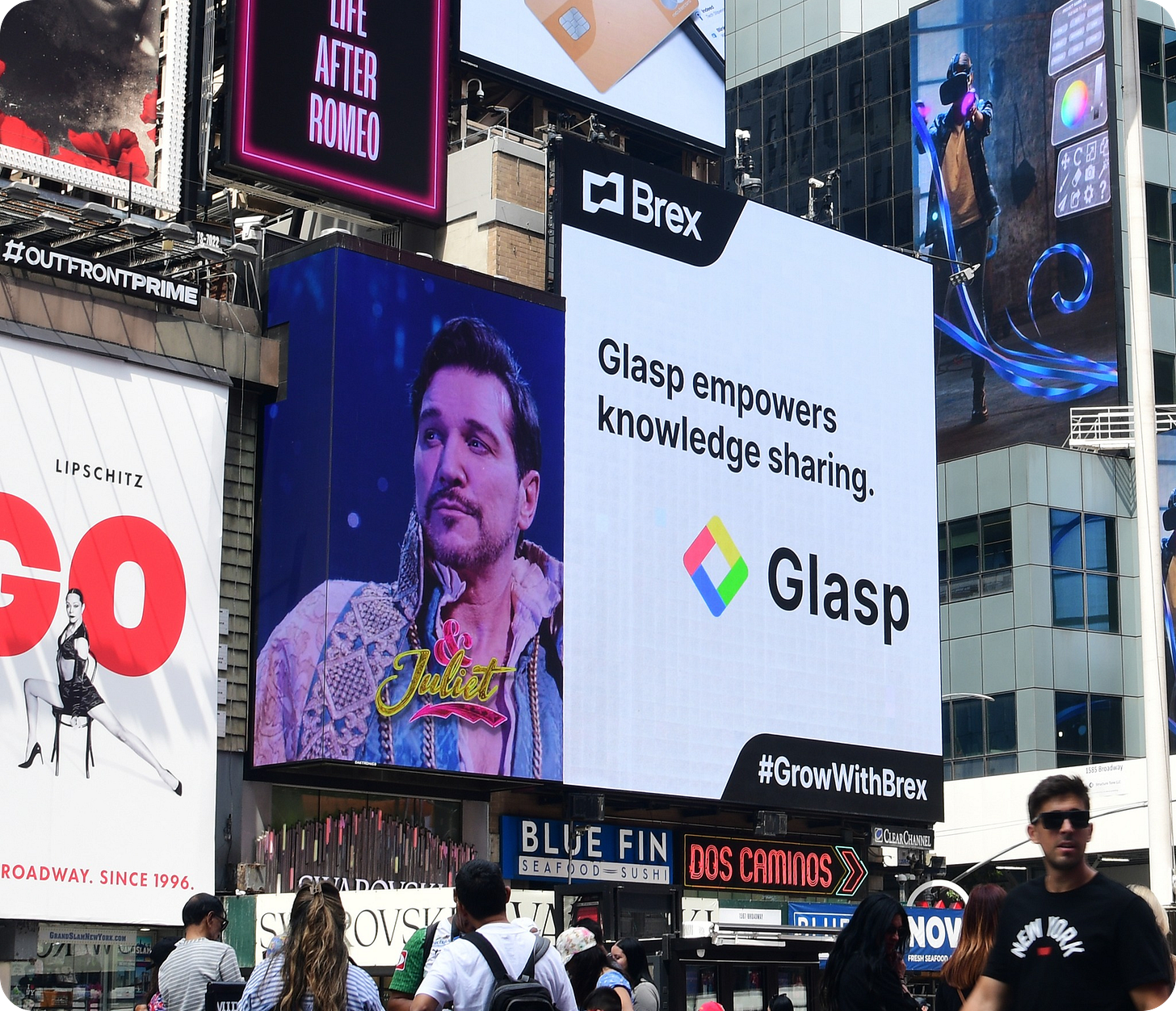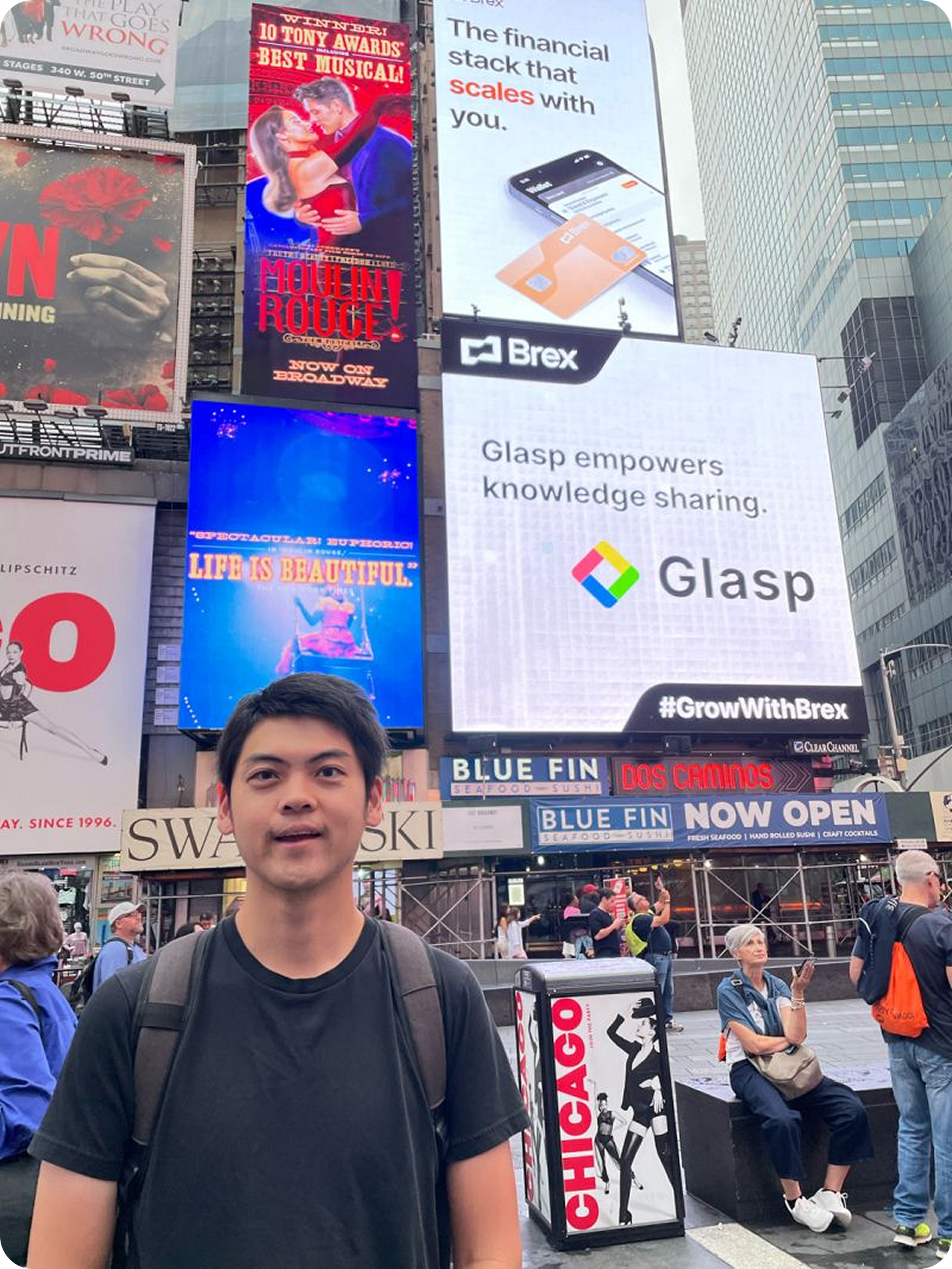Hatching Growth #11: How We Appeared on Times Square — for Free
Glasp’s note: This is Hatching Growth, a series of articles about how Glasp organically reached millions of users. In this series, we’ll highlight some that worked and some that didn’t, and the lessons we learned along the way. While we prefer not to use the term “user,” please note that we’ll use it here for convenience 🙇♂️
If you want to reread or highlight this newsletter, save it to Glasp.
Recap: #1–#10 in one glance
#3: How We Rode the AI Wave with Side Projects Before It Exploded
#8: How We Doubled Down on YouTube Summary with Programmatic SEO
#9: Acquisition-First, the AARRR Ladder, and Turning Core Actions into a Growth Engine
Introduction
This edition of Hatching Growth takes a different angle from our usual topics — it’s not about growth strategies, marketing hacks, or long-term bets like product-led growth or programmatic SEO.
Instead, it’s about a kind of “wild card” growth — the moments when progress doesn’t come from structured frameworks, but from bold, unexpected moves that shift your trajectory overnight.
Unlike more mature companies or B2B startups, where growth often follows a predictable path — building what customers request, forming sales teams, and executing marketing campaigns — early-stage B2C startups sometimes get the rare opportunity to skip all those steps through one unconventional, high-leverage move.
That’s the kind of story we’ll explore here.
For example, if Glasp had fully pivoted into the YouTube Summary space and deeply believed in that product’s long-term sustainability, we might have tried to connect with major creators like MrBeast or PewDiePie, invited them to make a small angel investment, and asked them to feature Glasp on their channels.
As we shared in the previous edition, we chose integration over pivoting, so we didn’t pursue that route. And of course, we’ve never met MrBeast or PewDiePie — this is just a thought experiment.
Still, in the early, scrappy stages of a startup — when you’re trying to get noticed, win attention, and outpace competitors — sometimes you need to be pulled up by people or platforms far above your level.
“Attention is all you need” became famous in AI, but it’s just as true for startups.
Breaking through the noise requires more than building features; it takes storytelling, creativity, and constant planting of seeds that can one day turn into visibility, trust, and support.
The Times Square Moment
August 24, 2023 – Times Square, New York City.
During an ODF (On Deck Founder) dinner sponsored by Brex, we casually asked one of the Brex team members if they had any perks or credits for startups — something like Google Cloud credits.
They said, “Not exactly, but… would you be interested in getting featured on Times Square?”
Of course, we said yes.
They shared a simple Google Form, we filled it out, and a few days later, Glasp was up on a massive digital billboard in Times Square.
The ODF community has continued to be part of our journey — we later interviewed Julian Weisser, a founder of ODF on Glasp Talk, where we discussed how communities like ODF empower and connect founders around the world.
Normally, How Does That Happen?
It turns out that Brex actually offers a “Billboard Rewards” program, which allows startups to redeem Brex points for out-of-home (OOH) ad placements — including billboards, transit displays, and airport signage (source).
In theory, that means getting featured on Times Square through Brex is possible if you’ve earned enough points and go through their campaign process, which includes planning, creative review, and scheduling (source).
In other words, it’s technically accessible, but not exactly “free.” You’re redeeming points and running a managed campaign like a traditional OOH placement.
In our case, however, we didn’t follow that formal path. The Times Square appearance felt more like a spontaneous opportunity — a true wild card moment that came from a casual conversation and a bit of luck.
What Happened After That
We checked Google Analytics carefully that day and week. Surprisingly, there was no noticeable increase in traffic.
However, the reaction on social media — especially on Facebook and LinkedIn — was incredible. People who already knew Glasp or had been cheering for us were genuinely excited to see us up there. It didn’t bring in new users, but it made the impact visible to our existing supporters.
For founders, this story often gets a great reaction. Even among startups that use Brex, many people don’t know this kind of opportunity exists — so when we share it, they see it as a clever little hack.
And for those outside the startup world, being featured in Times Square carries huge symbolic weight. Most people assume it costs a fortune, so just appearing there signals credibility, validation, and authority. In that sense, it also served as a small but powerful branding moment for Glasp.
It also became a fun story to tell —how we got featured on Times Square — for free. It’s the kind of thing that doesn’t move metrics, but moves hearts.
Brex and Managing Cash as a Startup
If you’re building a startup in the U.S., Brex is worth checking out — not only for its rewards and financial tools, but also for its Securities program, which allows you to earn yield on idle cash (around 4–5% APY at the time of writing).
That said, please note: we don’t take responsibility for any financial outcomes.
If you decide to use these programs, do your own research and make informed decisions — use them at your own risk. Regulations and tax implications differ by country, and there’s always a degree of financial risk involved.
For those interested in a deeper look into startup finance, we also interviewed CJ Gustafson, finance thought leader, creator of the popular Mostly metrics newsletter, and co-host of the Run the Numbers podcast on Glasp Talk — it’s a great conversation about how founders can think more clearly about their financial runway and capital allocation.
Takeaway
Sometimes, the most visible wins — like a Times Square feature — don’t show up in your dashboards. But they give your team energy, validate your story, and make your mission tangible.
In the early stages, not every move needs to follow a structured growth playbook.
Sometimes, a bold, unexpected wild card can open doors that careful planning never could.
But behind every wild card, there’s a mindset — the willingness to think out of the box, to start from zero base, to ask when you’re unsure, and to move fast when a chance appears.
When you stay curious, ask questions, and act with agility, unexpected opportunities tend to find you. And those moments — the ones you couldn’t have planned — often end up shaping your journey the most.
That, too, is a form of growth worth chasing.
What’s next?
In the next episode, we’ll explore another story — either a different kind of growth hack or something related to startup finance — to keep learning how small, creative decisions can drive meaningful impact.
Partner with Glasp
We currently offer newsletter sponsorships. If you have a product, event, or service you’d like to share with our community of learning enthusiasts, sponsor an edition of our newsletter to reach engaged readers.
We value your feedback
We’d love to hear your thoughts and invite you to our short survey.





This was one of my favorite moments in our journey, a reminder that not every milestone comes from a detailed plan or growth framework. Sometimes, the most meaningful progress comes from curiosity, spontaneity, and simply asking the right question at the right time. Moments like these remind me how serendipity often rewards openness and genuine connection. 🌱✨